Human osteology
The research on the human burials is carried out in cooperation with the Forensic Institute / University of Copenhagen. In 2003 Prof. Niels Lynnerup took care of the first burial discovered at Shkarat Msaied in building Unit F (Loc. 50111). In the following years Dr Marie Louise Schjellerup Jørkov took care of the work on the numerous burials exposed in Unit F. Until we can offer a full report on the human remains and the burials you will find below the published parts on the burials from various reports.
In addition you can also read about some findings here: http://videnskab.dk/kultur-samfund/danskere-finder-9000-ar-gamle-skeletter-med-makaber-historie or http://cphpost.dk/news/danes-discover-9000-year-old-skeletons-with-a-strange-history.html
On Human remains found at Shkārat Msaied from (published) reports
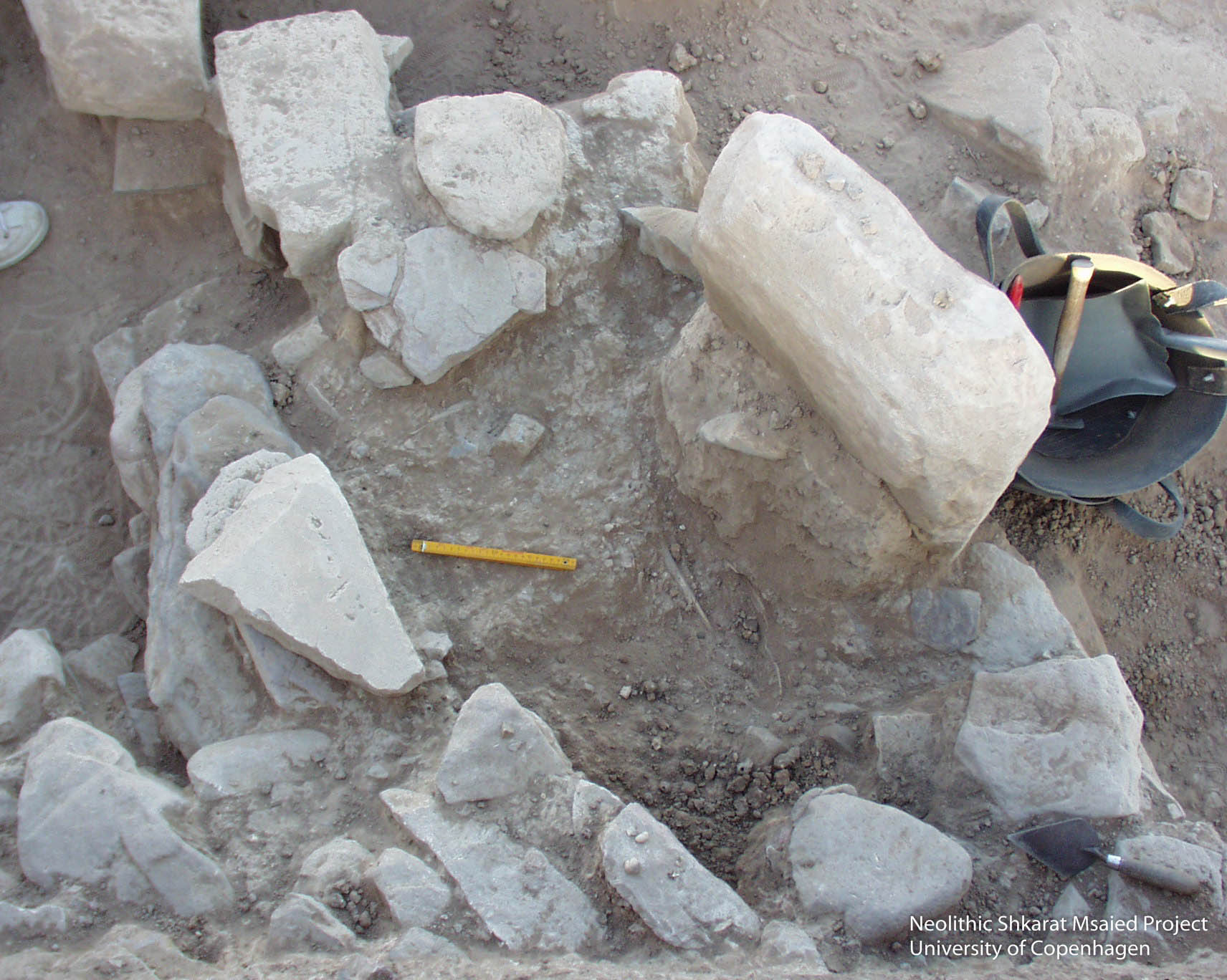
SM2002/2003 Burial (Loc. 50111) in unit F
Finds of the 2003 and 2005 season:
Burials (Hermansen et al. 2006. Neo-Lithics 1/06:3-5)
“Excavation at Unit F (Fig. l), a large house with a floor area of ca. 25 m2, but not subterranean, indicates that this house was set apart as an architectural frame for mortuary rites of the inhabitants. A minimum of 15 inhumations have been found in this house so far, and more can be anticipated. One burial, recovered already in 2003, consisted of the bones of a ca. 30-years-old female. Her arms had been placed inside the rib cage, the legs in front of it, and the skull and mandible were missing, probably having been removed in order to be subjected to one sort of ritual manipulation, as was accorded some individuals in the MPPNB. Found together with the burial were four ovi-caprine mandibles, suggesting that feasting may have been part of the practices associated with burial. This individual was buried in the stone cist found inside the building just to the right (east) when entering, and marked by a large monolithic slab (cf Hermansen and Jensen 2002: 92, fig. 6).
The stratigraphy of Unit F indicates that the original floor of the building was made of lime plaster. This plaster floor was cut at some point in time. Several subfloor stone cists, built of flat sandstone slabs, were then constructed, most of which contained human remains. Two small cists contained the burials of two and four infants, respectively. ln both cases, the burials were secondary and the skeletal remains were fragmentary. A third cist contained the bones of at least eight individuals, six adults and two sub-adults (Fig. 2). The bones were sorted very carefully, so that individual bodily identity had been totally dissolved: 7 skulls were laid down first in the southern part of the cist, all but one standing upright and facing north, and the last one resting on the facial part of the skull with skull cap facing the south. An eighth skull (of an adult) was already fragmented when buried, as the fragments were found scattered in the grave. A rib cage and vertebral column were found at the bottom of the grave in anatomical order. Lower extremities of one individual were found to be lying in an articulated position; however, left and right side had been separated. Most of the long bones had been placed in a north/south direction together with the flat bones such as hips and scapulae. Mandibles were mostly strewn in the center and surrounded by a scatter of ribs and vertebrae. The last skull to have been buried was resting on the other skulls in the southern part with articulated mandible. Two additional cists, one large and one small, were excavated, but no inhumations were found in either. Instead a very large greenstone bead was recovered in the fill of one of them. In the fill within and above the stone cists, additional fragments of human (and animal) bones and teeth were found, possibly indicating several events that would have caused disturbance to earlier burials, as well.
We hope that further excavation of Unit F and analysis of this material will allow us to gain detailed insights into the practices associated with burial in PPNB Shkārat Msaied.”
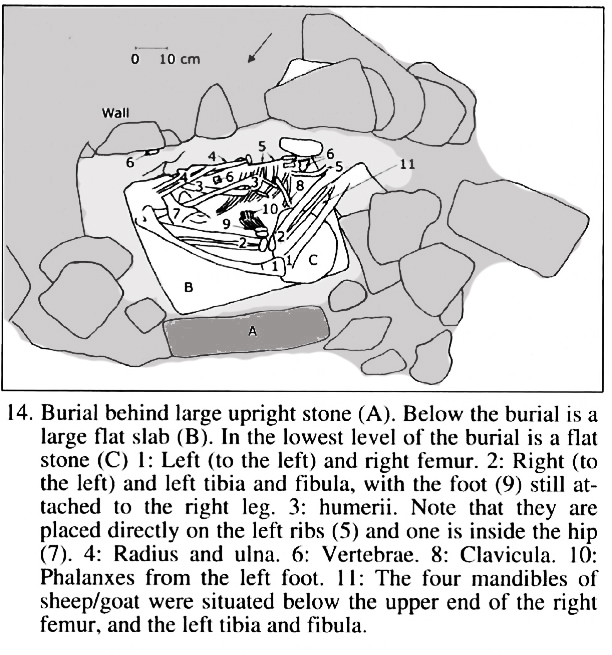
SM 2003: Burial in unit F (Loc. 50111) after Jensen et al 2005: Fig.14
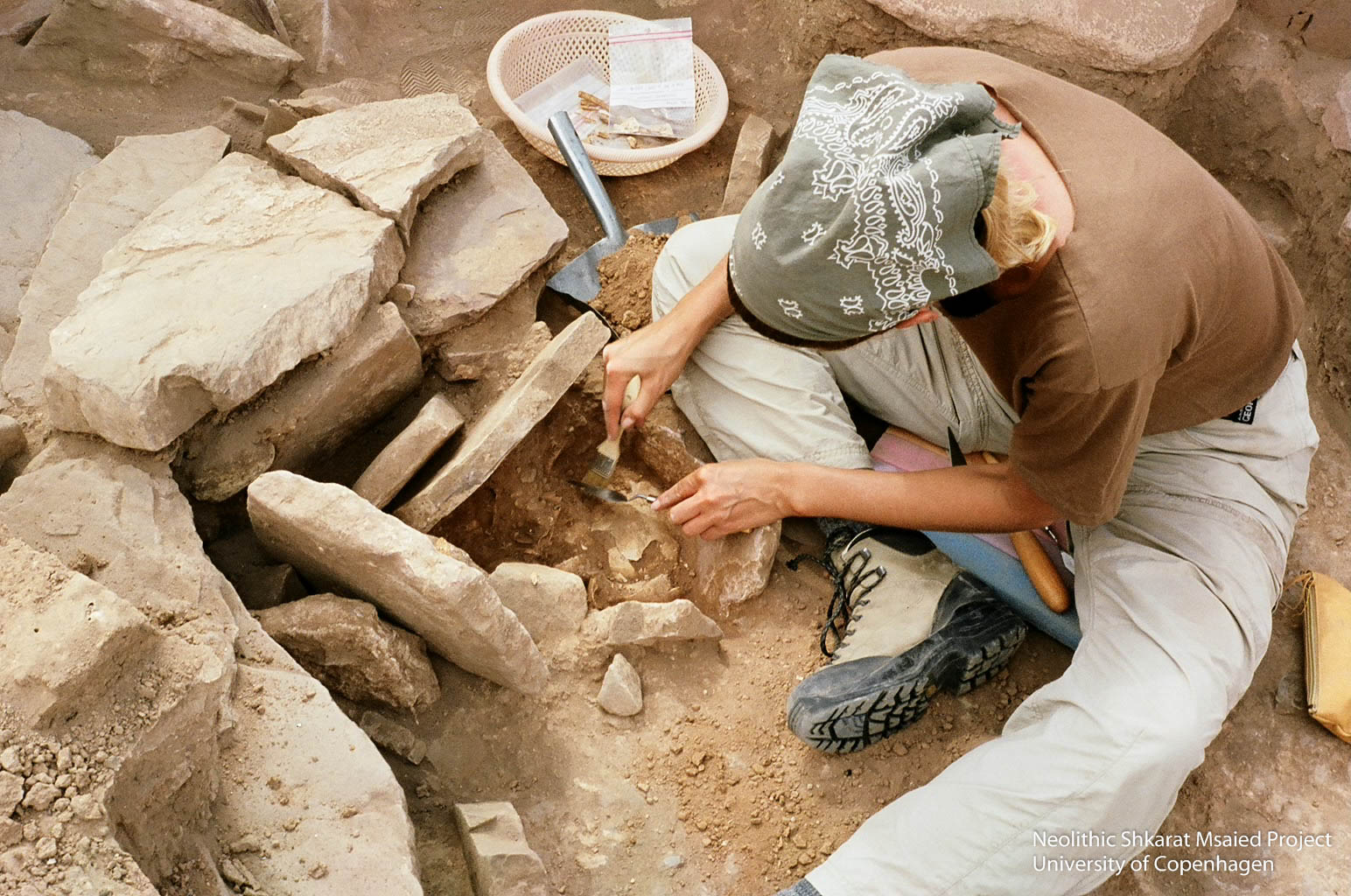
SM2005 Unit F: Excavating burial Loc. 70221.

SM2005 Unit F: burial (Loc. 80316)
Finds of the 2010 season:
Human Burials (Kinzel et al. 2011. Neo-Lithics 1/11: 46-48)
During the 2010 field season one burial cist (Burial 6) was discovered in the northeastern part of the building, and one intact burial of a child (Burial 8) in the southwestern area of building F. Additionally, disarticulated smaller human and animal bones were found in the surrounding fill of Burial 6 and between Burial 4 and 3 (Fig. 5). The area around it and the top of burial cist 6 were covered with several flat sandstone slabs, as was also the case with the other burial cists (Burials 2-5). The bones found in Burial 6 and the surrounding area belong to a total 3 7 individuals (MNI) - 17 adults and 20 sub-adults. Based on the unorganized positioning of the remains, it can be determined that the burials are secondary, as the bone remains were placed in the cist after decomposition had taken place. The bones seem to have been directly dumped into the cist without sorting or properly organizing them.
Due to the poor state of preservation of the remains, little pathology could be observed. However, one child ca. 1 year old exhibited small porotic pitting in the orbital roofs (mild cribra orbitalia [CO]). This may be related to anemia or malnutrition, although the etiology behind CO is manifold (Ortner 2003). The lesion was healed, suggesting recovery. Another child - estimated to be at the age of 6 years, showed horizontal lines in the enamel surface (enamel hypoplasia) on some of the not fully developed teeth (permanent canines and lateral incisors in the maxilla). These lines indicate a disturbance in the formation of the teeth (enamel) and could be due to possible malnutrition, high fever or similar stress of the body (Hillson 1996). The position of the lines suggests the disturbance occurred when the child was 1-2 years old. A few single adult remains displayed degenerative joint diseases in foot bones or vertebrae, which could be due to overuse and stress on joints.
Burial 8 consists of an articulated skeleton of a 2- year-old child. This is the only complete intact skeleton found in this building. The burial was oriented north-south with the face towards the west, and the child was placed in a foetal position (see Fig. 6). Similarly, a child burial was also found in the eastern area of building R, estimated to be 1 year old with the same foetal position close to the outer wall of the building. This burial is the first to be found outside building F, but this discovery does not change our previous interpretation of the function of building Fas "an architectural frame for mortuary rites of the inhabitants" (Hermansen et al. 2006: 3).
So far a total of 55 inhumations (MNI) have been retrieved from building F alone, and it is expected to find further burials in the areas below the rest of the plaster floor.
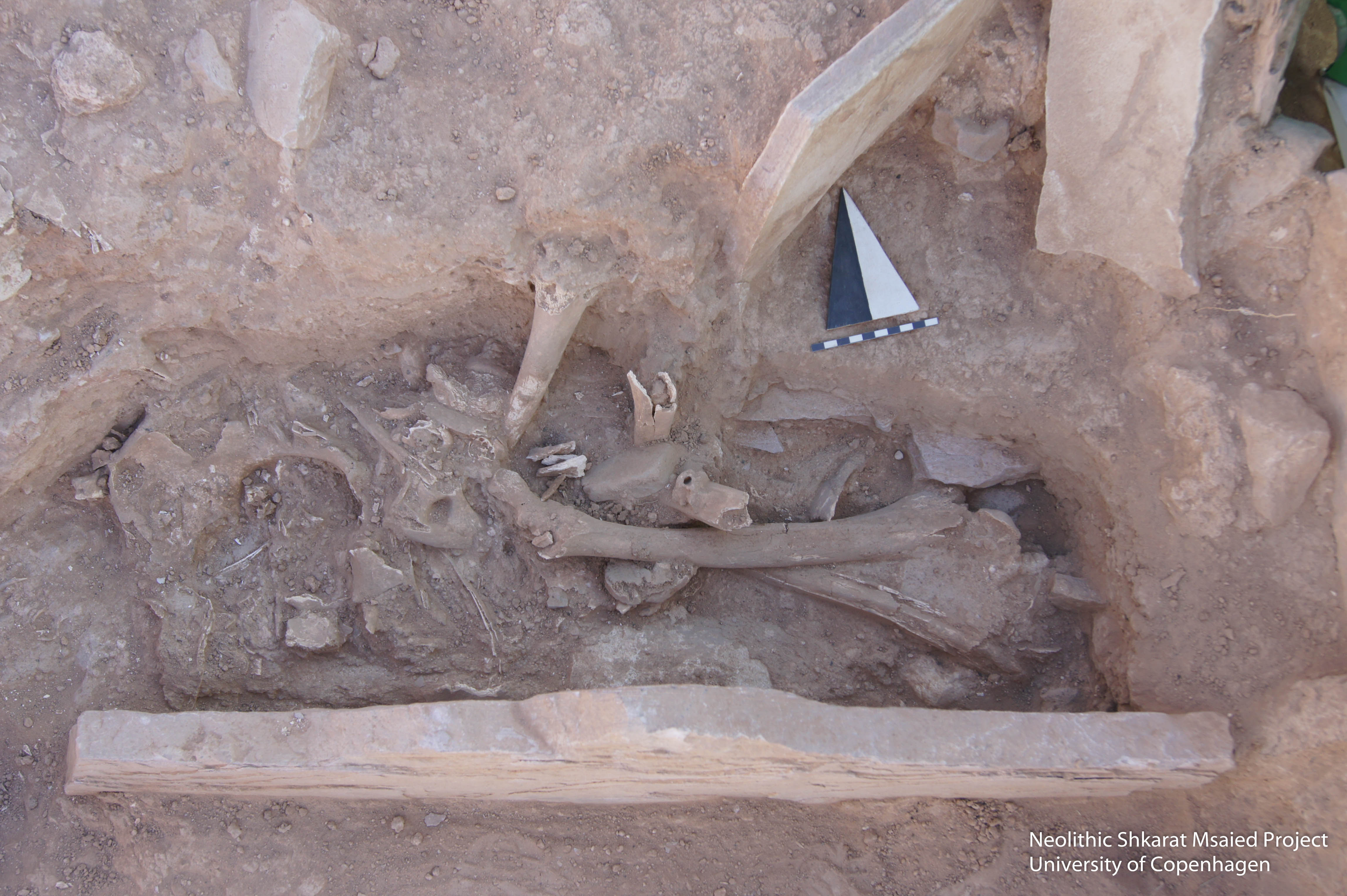
SM2010 Burial cist in unit F (Loc. 90120).
Finds from the 2015 season:
Preliminary results from the Unit F: Human remains (Kinzel et al. 2016. Neo-Lithics 2/15: 7-8)
Three areas containing human remains were excavated in Unit F. In total a minimum number of 12 individuals (10 sub-adults and 2 adults) were recovered. Up against the northern wall west of stone cist (Loc. 80.303) which was excavated in 2005, infant remains were recovered in the fill. A small stone cist could be identified. The stone cist contained the remains of minimum 3 sub-adults of which two were secondary burials (one was represented by a mandible [6-7 year old child, B115.102], one was the disarticulated remains of a 38-40 week old foetus/new-born [B115.104]). The last individual was of a c. 4 year old child buried resting on its left side with flexed arms and legs with the back towards the north wall (B115.103). The head and first cervical vertebra were missing. No pathology could be observed on the remains.
To the south east of locus 80.303, a deposit of intermixed remains was uncovered lying in a very hard soil. The deposit contained completely mixed up sub-adult remains of minimum 6 individuals: 1 juvenile 8 years (represented by a mandible), 1 child 5 years, 1 child 3-4 years, 1 child 2-3 years, 1 child 2-2,5 years, and 1 child 1,5-2 years. They have been placed at the same time and are likely a tertiary deposit. No pathology could be observed on these remains.
The third excavated area was a stone cist (Loc. 110.108) in the southern part of the house, immediately north of stone cist locus 110.109 and next to locus 110.128. The stone cist contained three skulls all facing west. Skull #1 had been placed while soft tissue was still partly present. This was evident from the first neck vertebrae (cervical 1 and 2) still articulating to the base of the skull. Furthermore, the mandible was articulating with teeth in occlusion. The skull belonged to a male aged ca. 30-45. He had suffered periodontal disease and had calculus on molar teeth. He had lost the second and third molar ante mortem. In their place a large abscess (healed) was seen, hence the little wear observed on the occluding mandibular molars. Skull #2 and #3 had their left side of the head up against and partly underneath the southern stone slab separating locus 110.108 from locus 110.109. The stone slab had been pushed down after burial and after the construction of the stone cist (Loc. 110.109) as well as the erection of wall locus w70.209/110.107. This had resulted in crushing of the left parietal bones of both crania. Skull #2 was located south west of skull #1 (Fig.9). There was no mandible, but it had all its maxillary teeth present. It belonged to a 3 year old child. No pathology could be observed on this individual. The third skull (Skull #3) belonged to a 6-7 year old child. Enamel hypoplasia could be identified on the permanent maxillary incisors, indicating a disturbance in the enamel production as a consequence of malnutrition or other stress related instances around the age of 3-3,5 years.
A complete animal humerus (Vulpes sp) was found east of Skull #3. An epiphysis of an animal tibia which may have been from a smaller cat was found as a secondary deposit in Skull #1. In the fill of locus 110.108 a foot bone (a metatarsal) was found from a juvenile c. 6-11 years old. In the fill of locus 110.128 an adult knee cap (a patella) was recovered. It showed initial stages of arthritis.
As the human remains of the 2015 season are mainly coming from the very same contexts excavated back in 2005 we will re-assess all the human remains to clarify the minimum number of individuals; especially in the case of Loc. 80.303.
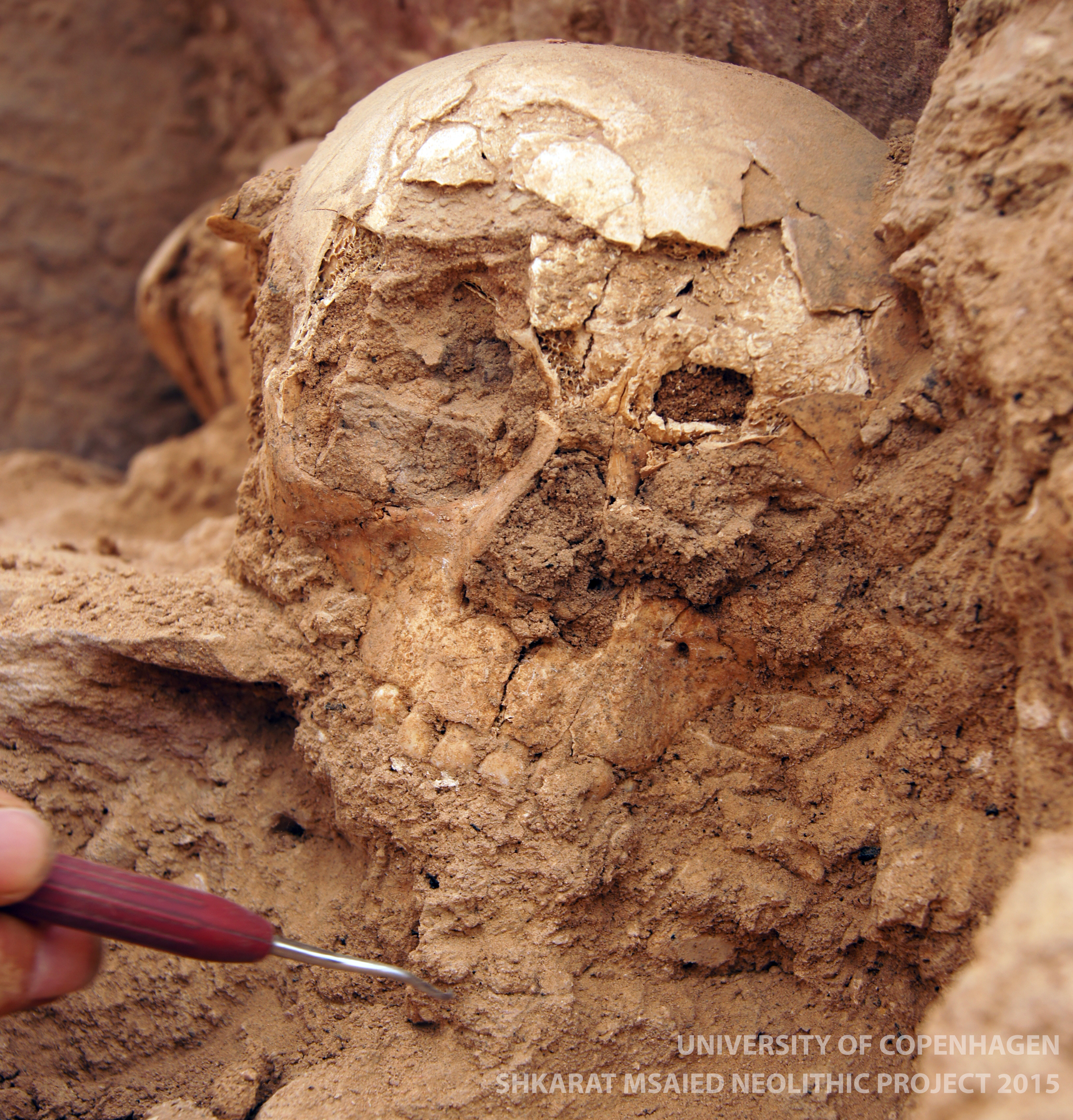
SM2015 Unit F: exposed skull #2 in Loc. 110.108.
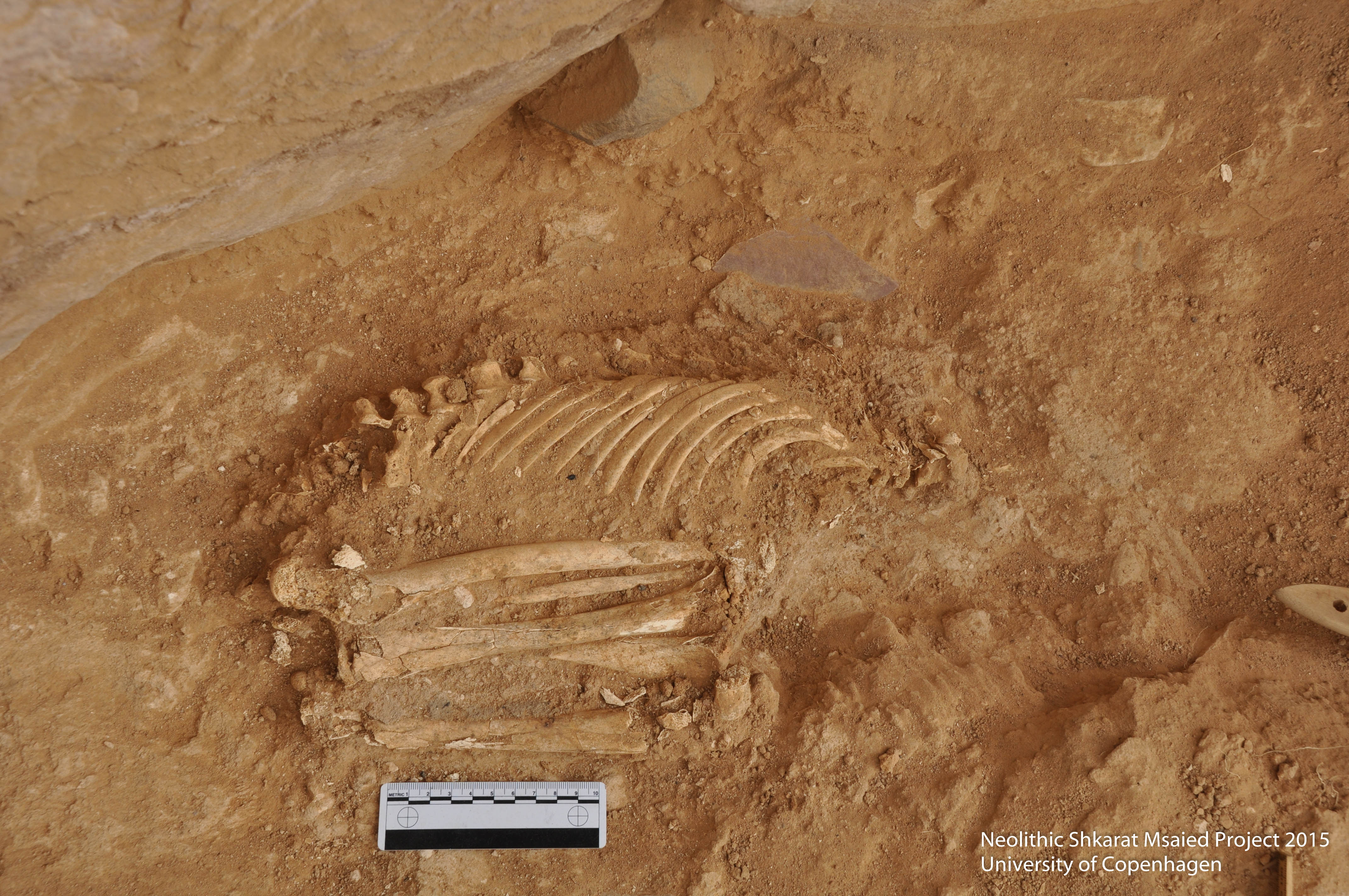
SM2015 Unit F: Child burial (Loc. 110.126)

